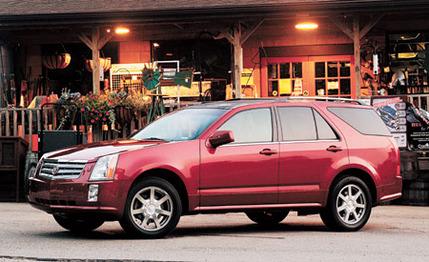 Long-Term Road Test
Long-Term Road Test
Less than a month into its stay here, and with a little over 4000 miles on the odometer, our long-term Cadillac SRX V-8 sport-ute was deemed the carriage of choice for a round-trip run from Ann Arbor to Boston, with tech editor and recent hire Dave VanderWerp at the wheel, and his then fiancée, Marie, riding shotgun. It was a perfectly sensible choice, not only because the $60,645 Caddy needed to accrue miles, but also because it was an ideal long-tripper-after all, for a starting price of $50,830, it was equipped with a gutsy 320-hp Northstar V-8 and leather front bucket seats with heat and eight-way power adjustments. Plus, it had $9815 worth of pampering options: all-wheel drive, a navigation system, a third-row power seat, magnetic ride control, HID headlamps, a DVD player with an LCD screen and wireless headphones ("Sorry, sweetie, did you say something?"), and a Bose stereo with XM satellite radio and an in-dash six-CD changer. Cruising cross country couldn't come any better, or so Dave and Marie thought.
At a rest stop off a New York toll road, our travelers returned from visits to the lav, only to discover that the SRX viewed the idea of rest stops literally. They fired up the engine, but on exiting the parking lot, it stalled, as if to say, "No! Enough for one day!" All attempts to restart failed. Thinking that maybe OnStar could wake up the fatigued Caddy, VanderWerp pushed the magic blue button and was instructed by an unsurprised operator to leave the key (which was stuck in the column) in the "on" position for 20 minutes and then the "off" position for five seconds. Then he could try to restart the vehicle.
That oddball fix didn't work, so VanderWerp disconnected and then reconnected the battery, a last-ditch effort that worked, but just temporarily. Later on in Boston, the SRX subsequently stalled several more times. VanderWerp was able to keep it going by disconnecting and reconnecting the battery, but a more lasting fix was certainly called for. The SRX was ditched at Frost Motors, a Boston-area Caddy dealership, while VanderWerp and his fiancée were forced to fly home.
A week later, the perplexed service department at Frost could not find the culprit and was set to release the SRX with a no-see-um bill of health. So VanderWerp flew back for a second attempt to drive our wagon home, only to be stranded en route in Albany, New York, when the SRX quit again. At that point, VanderWerp-now used to this routine-found the nearest airport and flew home. (We did not tally the $1800 in airfares into the SRX's service costs.)
According to Otto Cadillac in Albany, our SRX had been born with a bad engine-control module, a defect that required 10 days in the inspection pits to detect. Like a clogged artery, the problem was physically small, its consequence huge. GM picked up the bill under warranty, of course, the first of three instances in which the General was forced to delve into its pockets. The second, at 15,842 miles was to convince the huge UltraView sunroof that "close" did not mean "crack," and the third, at 20,411 miles, was to replace a faulty key and remote. So the lesson here seems to be that although technology can do lots of trick things, it can also play irritating tricks.
Still, there was good news, too. If you can overlook a rather steep $465 unscheduled service at 31,589 miles that required replacing the brake pads and resurfacing the front and rear rotors, our three scheduled service visits were cheap, totaling just $236. Like many cars today, the SRX has an oil-life monitoring system that prompts the driver when it's time to change the crude. For us, the service indicator came on at about every 10,000 miles; that frequency of course depends on the type of driving you do.
The SRX is an elegant, fast, comfortable SUV that has few peers. When new, it ripped from 0 to 60 in 7.1 seconds and through the quarter-mile in 15.4 at 92 mph. Those are quick numbers for an SUV, especially one that weighs 4711 pounds. More impressive was the SRX's top speed of 141 mph-faster than many of today's so-called sporty cars. When we retested the SRX at 40,000 miles, it was not only quicker but also faster. Zero to 60 dropped to 6.8 ticks, the quarter improved to 15.2 at 93, and top speed rose to 144. Who says getting old slows you down? Moreover, braking and skidpad grip improved over the long haul, with the former dropping from 188 feet to 183 in 70-to-0 halts and the latter jumping from 0.78 g to 0.79. Even better was that our intemperate hot-rodding still netted a respectable 17 mpg.
And, yes, there was plenty of hot-rodding, evidenced by the abundance of praise heaped on the SRX's ability to quickly gobble asphalt. Glowing logbook entries included everything from "accelerates better than you'd expect" and "plenty of power" to "I love the Northstar!" and "terrific traveling companion." Applause was also handed out to the five-speed automatic, which shifted seamlessly and made mountain driving worry-free, thanks to the manumatic feature that enabled the driver to hold a lower gear.